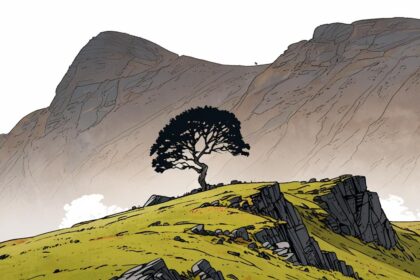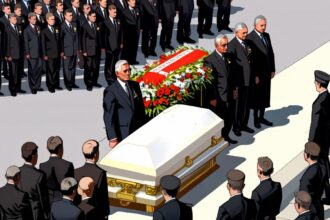Tirana is experiencing a dramatic surge in the construction of multi-storey luxury towers, with apartment prices reaching unprecedented heights of up to 10,000 euros per square metre. This boom is reshaping the capital’s skyline and positioning the city as a regional hotspot for high-end property investment, driven largely by foreign buyers and affluent investors.
Tirana is undergoing a significant urban transformation marked by a surge in the construction of multi-storey towers across various parts of the city, including areas surrounding the former Blloku district, near the historic centre, and on state-owned properties such as locations under the Paris Municipality, the Faculty of Civil Engineering, the former Telegraph News Agency (ATAH), and the vicinity of the Artificial Lake.
This construction boom is leading to the development of buildings reaching heights of up to 40 floors, signalling a shift towards high-rise luxury living. Real estate agencies report that sale prices for apartments in upcoming premium projects, particularly near the Artificial Lake, have soared to as much as 10,000 euros per square metre. This figure represents a record high for the Albanian property market.
Developers, speaking to Monitor, attribute these high prices to the exclusivity and quality of the residences, which are tailored for a select market comprising foreign investors and economically affluent individuals globally. They describe the properties not simply as apartments but as expansive residential suites featuring contemporary architectural design, high-grade construction materials, and a range of premium amenities.
These state-of-the-art towers offer panoramic city views, employ advanced construction technologies, and prioritise safety measures against natural disasters. They also provide premium services comparable to those found in leading European hotel brands, luxury retail options, dedicated fire emergency elevators, generous floor heights reaching up to four metres, and communal areas designed to international standards.
The trend of rising prices has been steady and progressive. Earlier phases of tower development in 2022 and 2023 saw prices considerably lower, such as in the “Book Building” tower near Tirana Clock where prices began at 5,000 euros per square metre. Similarly, buildings near the Presidency offered apartments at 4,000 to 4,800 euros per square metre during that period. Another example is the “Rainbow Center” in the former Blloku area, a seven-storey structure with the first two floors serving as a shopping centre, where prices reached 5,000 euros per square metre.
“Eyes of Tirana,” another prominent project, saw its residential units initially priced over 3,500 euros per square metre, with commercial premises commanding between 6,000 to 8,000 euros per square metre. In the “Brigada” street area within the former Blloku, apartment prices in ongoing developments are reported to reach up to 5,000 euros per square metre for 2025.
In comparison to other Western Balkans capitals, Tirana’s luxury property prices are outpacing the regional average. For instance, a record sale in Belgrade reached approximately 11,811 euros per square metre, though average prices in new developments there hover around 3,941 euros per square metre. In Croatia, luxury coastal properties can command prices up to 8,000 euros per square metre. Montenegro experienced prices close to 10,000 euros per square metre before recent economic disruptions but has since seen a decline to between 5,000 and 7,000 euros.
Stela Dhami from Colliers International Albania noted that these market prices “reflect demand, economic development and purchasing power.” She commented, “Albania, along with Bosnia, traditionally offered more affordable prices, but in Tirana we are seeing an exception due to demand focused on elite projects,” highlighting the city’s distinctive position.
However, experts acknowledge that the current price levels, situated within a country where average incomes remain comparatively lower than in neighbouring regions, raise questions about affordability for local residents. The local market appears bifurcated, with ultra-luxury developments catering predominantly to elite buyers and foreign investors, while the demand for more affordable housing is being met mainly in suburban districts. For example, prices in suburbs such as Paskuqan and Shkoza range from 900 to 1,400 euros per square metre, contrasting sharply with downtown figures where prices rarely fall below 2,000 euros per square metre.
Data from the Bank of Albania’s Fischer Index indicates a rapid acceleration in housing price growth during the latter half of 2024. The index revealed that average home prices increased by 23.6% over the previous six months and by 44.5% compared to the same period a year earlier. Additionally, approximately 18% of housing purchases in this period were made by non-resident buyers, with citizens from European Union countries accounting for about 77% of these transactions. This trend of increasing non-resident participation in the real estate market has been consistently rising over the past five years.
This ongoing development and pricing pattern illustrate Tirana’s evolving urban landscape and its emergence as a hub for high-end real estate within the Balkans, driven by both domestic transformations and international demand.
Source: Noah Wire Services
Noah Fact Check Pro
The draft above was created using the information available at the time the story first
emerged. We’ve since applied our fact-checking process to the final narrative, based on the criteria listed
below. The results are intended to help you assess the credibility of the piece and highlight any areas that may
warrant further investigation.
Freshness check
Score:
6
Notes:
The narrative mentions recent developments and pricing figures up to 2025, indicating relatively fresh content. However, specific dates or events are not extensively detailed, suggesting potential recyclability without strong time-pegged information.
Quotes check
Score:
8
Notes:
The only quote found is from Stela Dhami, which appears original and specific to this context, lacking an earlier source online to compare.
Source reliability
Score:
5
Notes:
The narrative does not specify a well-known publication source. Although the information seems structured and includes insights from a reputable agency like Colliers International, this lack of explicit attribution impacts reliability.
Plausability check
Score:
8
Notes:
The claims about Tirana’s property market and comparisons with other Western Balkans cities are plausible given current trends and economic shifts. However, without supporting evidence for all specific figures and claims, verification is challenging.
Overall assessment
Verdict (FAIL, OPEN, PASS): OPEN
Confidence (LOW, MEDIUM, HIGH): MEDIUM
Summary:
While the narrative presents a plausible scenario of Tirana’s real estate growth, the freshness and source reliability could be improved. The absence of specific dates and explicit publication attribution means confidence in the assessment is medium.













